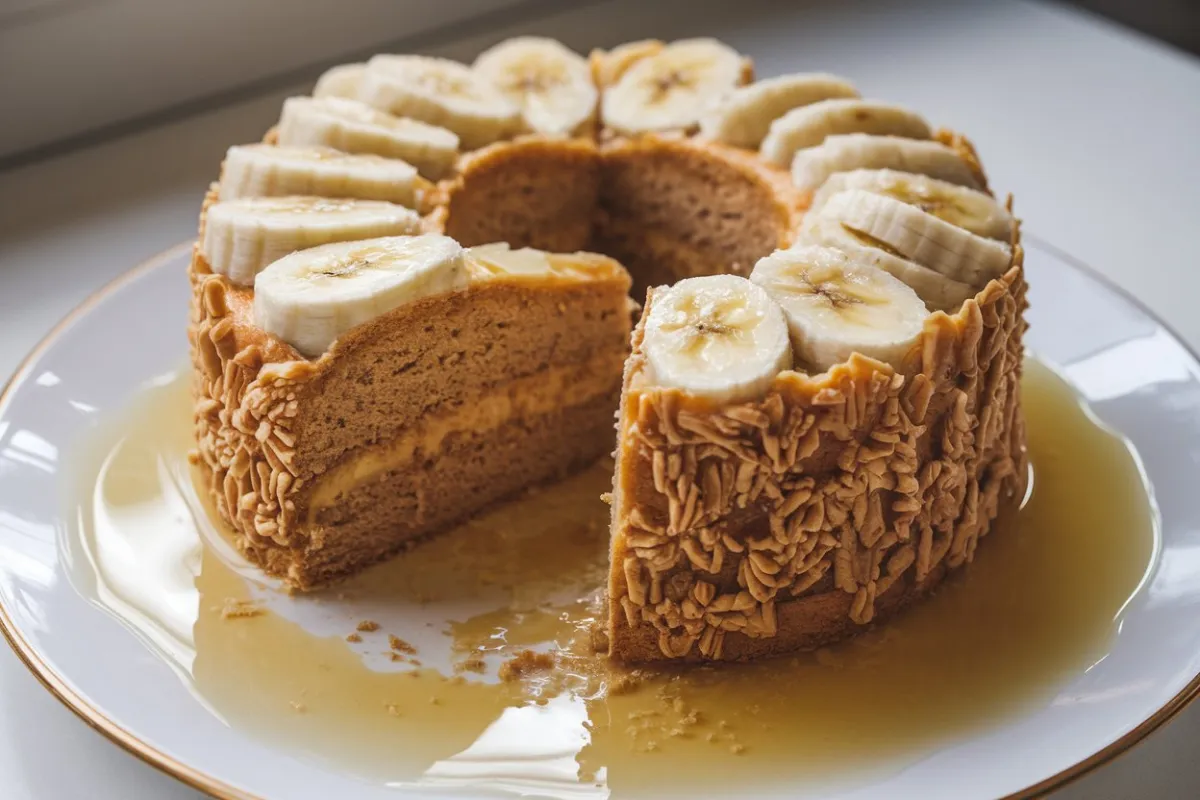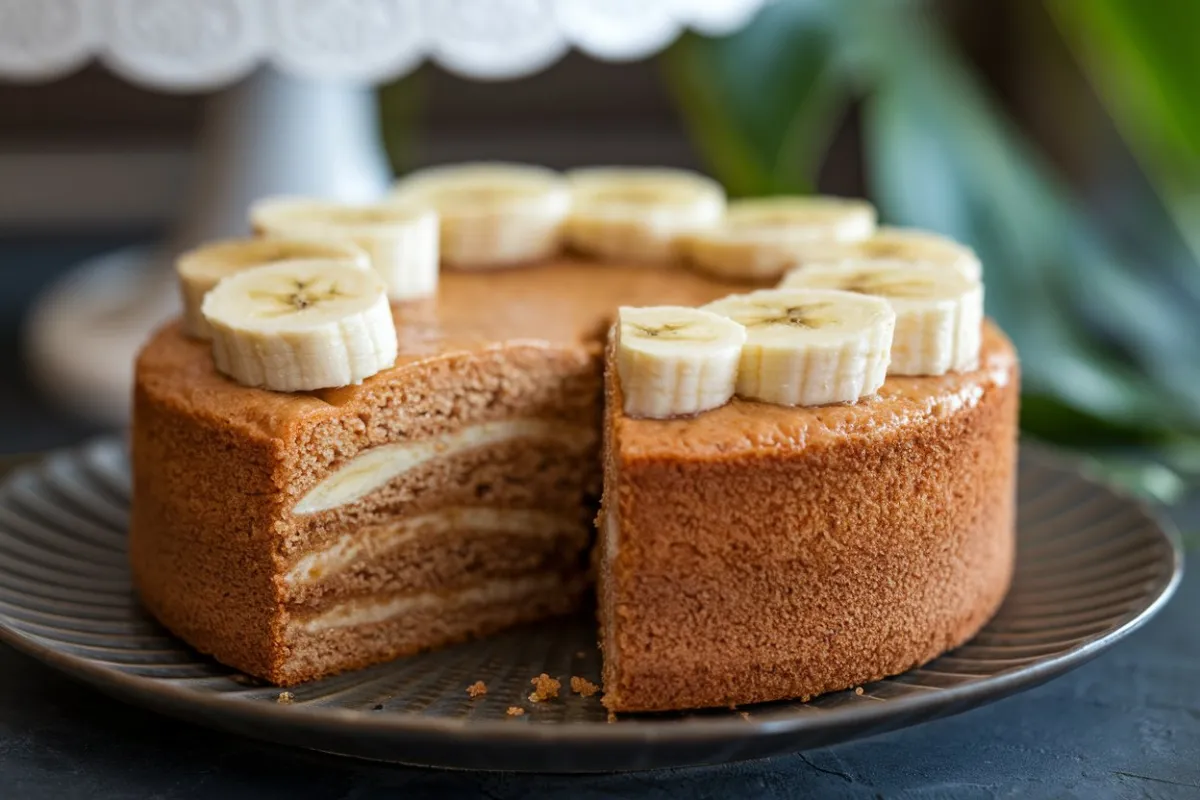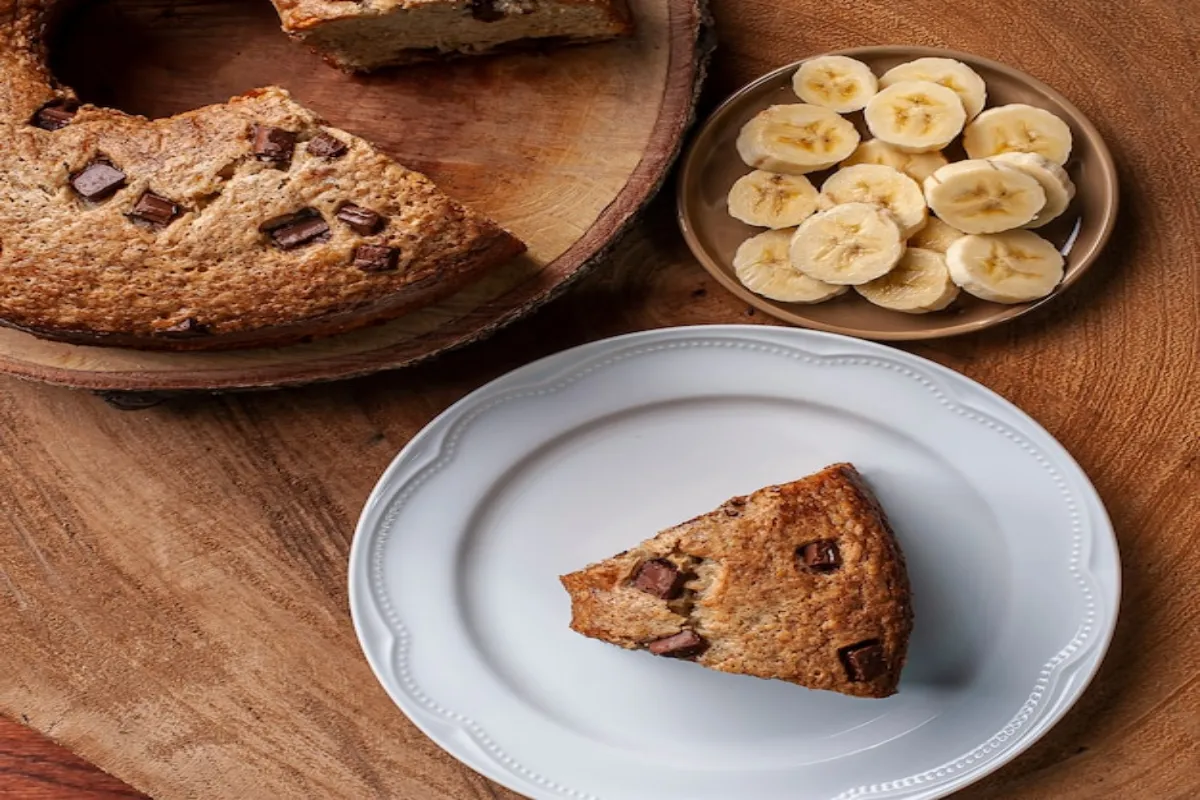Baking the perfect banana cake can be a rewarding experience, but sometimes things don’t turn out quite right. One of the most common issues bakers face is soggy or overly moist banana cake. A cake that’s too wet can ruin the texture and taste, leaving you disappointed. Do not worry—this guide will explain why your banana cake is soggy, how to prevent it, and how to fix it.
1. Common Causes of Soggy Banana Cake
Several factors can lead to soggy banana cake. Let’s look at the most common reasons to identify where things might have gone wrong.
Overripe Bananas
Of course, bananas are one of the key ingredients in a banana cake. However, using bananas that are too ripe can add excess moisture to the cake, making it soggy. While overripe bananas are perfect for flavor, they can carry more water content than firmer, less ripe bananas.
Solution: Choose bananas that are ripe but not overly mushy. If your bananas are too ripe, you can reduce the other liquid ingredients slightly to compensate for the extra moisture.
Too Much Liquid in the Battery
Adding too much liquid to your cake batter, whether it’s milk, water, or even eggs, can cause your banana cake to become overly moist. Even though banana cakes require a certain level of moisture to remain tender, an excess can lead to a soggy texture.
Solution: Always follow the recipe closely and measure your liquid ingredients carefully. If you notice that your batter is runnier than usual, consider adding a little extra flour to balance it out.
External Link: To learn more about avoiding excess moisture in cakes, check out Baking Kneads’ tips on fixing wet banana bread.
Underbaking
Sometimes, your cake may look done on the outside, but the inside remains undercooked. This can leave you with a soggy center, even if the cake appears golden brown. Baking times are crucial, and removing the cake too early is a common cause of sogginess.
Solution: Always check the center of your cake with a toothpick or a cake tester before removing it from the oven. If the tester doesn’t come out clean, leave the cake in the oven for a few more minutes.
High Moisture Ingredients
Adding ingredients with high moisture content, such as extra fruits or even too many bananas, can also result in a wet cake. While experimenting with flavors can be fun, it’s important to adjust other ingredients accordingly.
Solution: If you add extra ingredients, such as fruits, reduce the liquid content of the batter or increase the amount of flour to absorb the extra moisture.
Oven Temperature Problems
An oven that is too hot or too cold can significantly affect how your cake bakes. A low oven temperature may cause the cake to cook too slowly, allowing excess moisture to remain inside, while a too-hot oven might cook the outside too fast, leaving the inside underdone.
Solution: To ensure accurate oven calibration, invest in an oven thermometer. Follow the recommended temperature settings in your recipe and avoid opening the oven door frequently, as this can cause temperature fluctuations.
2. How to Prevent Your Banana Cake from Becoming Soggy
When it comes to avoiding soggy banana cakes, prevention is key. Here are some practical tips to ensure your cake comes out perfect every time.
Choosing the right bananas
The ripeness of your bananas has a significant impact on the moisture level of your cake. While very ripe bananas can add sweetness, they can also add too much moisture.
- Tip: Opt for bananas that are yellow with a few brown spots but aren’t completely mushy. You’ll still get the sweetness without the excess water content.
Adjusting Liquid Ingredients
If you notice your batter seems too wet, reducing the liquid ingredients is an effortless fix. Eggs, milk, and even oil contribute to the overall moisture level.
- Tip: Experiment by slightly reducing the amount of milk or water in the recipe. Alternatively, you can add a little extra flour to balance the moisture levels.
The correct baking times
It’s crucial to bake your cake for the correct duration to prevent a soggy texture. An undercooked cake will almost always turn out wet in the middle.
- Tip: Use the toothpick method to check for doneness. If the toothpick emerges clean or contains only a few moist crumbs, the cake is ready. If it comes out with wet batter, it needs more time in the oven.
Internal Link: If you’re making a banana cake with no-bake cheesecake filling, make sure the cheesecake layer is well set to prevent excess moisture from the filling from affecting the cake.
Proper mixing techniques
Overmixing your batter can cause gluten to develop, leading to a dense, soggy cake. Under-mixing can also leave lumps of wet ingredients that don’t bake properly.
- Tip: Just combine the ingredients in your batter. Avoid using high speeds on your mixer, and fold in any extra ingredients by hand, such as nuts or chocolate chips.
Using the Right Oven Temperature
Temperature fluctuations during baking can lead to uneven cooking, resulting in soggy spots. A well-calibrated oven is crucial for a perfect banana cake.
- Tip: To ensure that your oven temperature is accurate, use an oven thermometer. Set the temperature according to your recipe and avoid opening the oven door too often while baking.
External Link: For more detailed tips on avoiding sogginess, check out Miss Vickie’s guide on fixing too moist banana bread.
3. Fixing a Soggy Banana Cake: Troubleshooting Tips
Sometimes, even after all your precautions, your banana cake may still turn out soggy. Don’t worry—there are several ways to fix it or prevent it from happening again.
Check the internal temperature.
Checking the internal temperature of your banana cake is one of the best ways to confirm its full cooking. A perfectly baked cake should have an internal temperature of around 200°F (93°C).
- Tip: Use a food thermometer to check the temperature at the center of the cake. If it’s below 200°F, it needs more time in the oven.
Re-baking the cake
If you’ve already removed the cake from the oven and realize it’s underbaked or soggy in the middle, you can still salvage it by re-baking.
- Tip: Preheat the oven and place the cake back inside for 10-15 minutes, checking frequently to ensure it doesn’t overbake.
Improving Texture in Future Bakes
If sogginess is a recurring problem, adjusting the recipe can help improve the texture of future cakes.
- Tip: Consider adding more dry ingredients like flour or oats, which can absorb excess moisture. Reduce sugar in the recipe because it attracts moisture.
Internal Link: Explore more tips for baking with moist fruits in recipes like the orange juice cake, where balancing moisture is key.
Reduced moisture content
If you find that the cake tends to be too wet despite following the recipe, reducing the moisture content can improve the overall texture.
- Tip: You can try decreasing the amount of liquid ingredients slightly or substituting some of the wet ingredients with dry alternatives, such as powdered milk.
4. Moisture Levels: What Makes the Perfect Banana Cake?
Achieving the right moisture balance is crucial to creating the perfect banana cake. Here’s what you need to know to get that perfect texture every time.
The ideal consistency
A perfect banana cake should be moist but not soggy, with a tender crumb and a slightly dense texture due to the bananas. When sliced, it should hold its shape, but it should still be soft enough to melt in your mouth.
- Tip: Achieve the ideal consistency by using the correct proportion of wet to dry ingredients. A useful rule of thumb is to balance every cup of liquid with about two cups of flour.
Role of Eggs, Flour, and Sugar
The balance of eggs, flour, and sugar plays a vital role in determining the moisture level of your cake. Too much sugar can make the cake too wet, while not enough flour can prevent it from holding together.
- Tip: Follow your recipe closely and measure these ingredients accurately to achieve the right balance of moisture and structure.
Common Mistakes with Moisture
Some bakers make common mistakes that lead to too much moisture in the cake. These include adding too many bananas, using the wrong size eggs, or overmixing the batter.
- Tip: Stick to the recipe’s recommendations for ingredients and quantities. If you want to experiment with the recipe, make small changes and observe the results.
Signs of a Perfect Banana Cake
How can you tell when your banana cake is just right? Here are the signs:
- The cake has a golden-brown color.
- A toothpick inserted into the center comes out clean, or with a few moist crumbs.
- The cake is firm, but springy to the touch.
- The cake holds its shape when sliced.
5. How to Store Banana Cake to Avoid Moisture Issues
Even if you bake the perfect banana cake, improper storage can lead to moisture problems. Follow these tips to store your cake correctly.
Proper cooling before storage
Allowing your banana cake to cool properly before storing it is essential. Storing a cake while it’s still warm can trap steam, making it soggy.
- Tip: Let the cake cool completely on a wire rack for at least an hour before storing it.
Best Methods for Storing Banana Cake
You can store banana cake at room temperature, in the fridge, or in the freezer, depending on how soon you plan to eat it.
- Room Temperature: Store the cake in an airtight container for up to three days.
- Refrigerator: To keep the cake fresh for up to a week, refrigerate it. To prevent it from drying out, wrap it in plastic wrap.
- Freezer: For long-term storage, freeze the cake. Wrap individual slices in plastic wrap and then in aluminum foil to keep moisture out.
Freezing and Thawing
Freezing banana cake is an excellent way to keep it moist for longer periods. However, improper thawing can lead to soggy cake.
- Tip: Thaw the cake by letting it sit at room temperature for a few hours. Avoid microwaving frozen banana cake, as this can make it soggy.
External Link: For more storage tips, visit The Kitchen Professor’s guide on keeping banana bread moist.
6. Alternative Recipes to Prevent Sogginess
If you’re struggling with soggy banana cakes, trying alternative recipes can help. These recipes aim to reduce excessive moisture while maintaining a moist and tender crumb.
Recipes with Drier Bananas
Some recipes work better with drier bananas or less ripe bananas, which contain less water.
- Tip: Use bananas that are just turning yellow rather than fully ripe. This will provide a firmer texture and less moisture in the batter.
Adding Textures to Balance Moisture
Incorporating additional textures, like nuts, oats, or shredded coconut, can help balance out the moisture and improve the texture of your cake.
- Tip: Add up to a cup of your favorite mix-ins to the batter to help create a more balanced texture.
Alternative Flours
Using alternative flours, such as almond or coconut flour, can help to absorb moisture and prevent a soggy cake.
- Tip: Substitute 25-30% of the all-purpose flour with almond or coconut flour to help absorb excess liquid while keeping the cake light and moist.
7. Expert tips for baking the perfect banana cake every time
Sometimes it’s the little things that make a big difference. Here are some expert tips to help you bake the perfect banana cake every time.
Professional Bakers’ Advice
Professional bakers recommend using precise measurements and following the recipe closely to achieve the right texture.
- Tip: Weigh your ingredients using a kitchen scale for the most accurate results, especially with flour and liquid ingredients.
Tools and Equipment
Having the right tools can also make a difference. Invest in high-quality baking pans, thermometers, and mixing equipment.
- Tip: Use a non-stick pan to prevent sticking and ensure even baking.
Temperature Control
Maintaining a consistent oven temperature is critical for even baking. Fluctuating temperatures can cause uneven cooking and soggy centers.
- Tip: Preheat your oven for at least 15 minutes before baking, and avoid opening the oven door while baking.
8. FAQs
Why is my banana cake soggy in the middle?
A soggy middle is often the result of underbaking or an oven that’s too cool. Be sure to check the center of your cake with a toothpick to ensure it’s fully baked before removing it from the oven.
How can I make my banana cake less wet?
Reduce the liquid ingredients slightly, use firmer bananas, and bake the cake for the entire duration to make it less wet.
Can I fix a soggy banana cake?
Yes, you can often fix a soggy banana cake by placing it back in the oven for a few more minutes. This can help firm up the center and remove some excess moisture.
What happens if my oven temperature is too low?
If your oven is too low, your cake may cook too slowly, leading to an undercooked or soggy center. Be sure to preheat your oven and use an oven thermometer to ensure accuracy.
How can I make sure my banana cake bakes all the way through?
Using the toothpick method is the best way to ensure your cake has baked fully. If the toothpick emerges clean, your cake is ready. If it comes out with wet batter, it needs more time in the oven.
Conclusion
Achieving the perfect banana cake isn’t as hard as it seems once you know how to avoid common pitfalls like excess moisture. By understanding why your cake might be soggy and taking steps to prevent it, you’ll be able to bake delicious, moist, and perfectly textured banana cakes every time. Whether you’re making a classic banana cake or experimenting with new flavors, these tips will help you create a dessert that’s sure to impress.
For more baking inspiration, check out the Snickers Strawberry Cheesecake Recipe for another delightful dessert!


